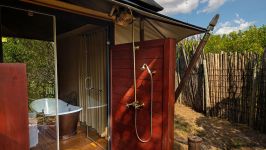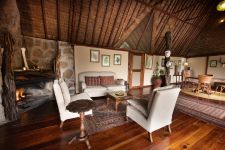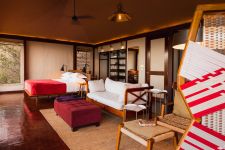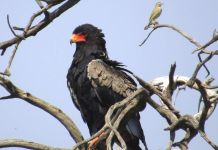Discover Amboseli: An Expert Guide to Planning Amboseli Safari
“Safari is about the beauty of the land, the thrill of the chase, and the spirit of adventure woven into the fabric of the African landscape.” – Romi Boom
A Brief Overview of Amboseli National Park
Amboseli National Park is a stunning destination known for its incredible wildlife and breathtaking scenery. With rich savannas and swamps, it’s home to some of Africa's largest elephant herds. Witnessing these magnificent creatures up close is an experience like no other. Amboseli National Park is a designated Important Bird Area (IBA) and Key Biodiversity Area (KBA).
The park’s iconic backdrop, Mount Kilimanjaro, adds a spectacular touch to your adventure. The views are truly unforgettable, especially at sunrise or sunset when the mountain peaks glow in vibrant hues. The wetlands including Lake Amboseli are the landscape's most defining and iconic feature. With groundwater seeping up and with natural springs feeding an underground drainage system from the forested catchments and volcanic soils of Mount Kilimanjaro and the Chyulu Hills.
Amboseli offers enchanting scenic views to the east where the volcanic Chyulu range and lava forests stretches into Tsavo West National Park. To the north, there are equally alluring views of a series of hills which include the Losoito, Lemipoti, Ilng’arunyoni and Lemomo hills.
Beyond wildlife encounters, a visit to Amboseli Nationa Park is to get an opportunity to immerse in Maasai culture. Engaging and learning about this local community will offer deeper insights into their traditions and way of life while supporting sustainable tourism initiatives. A good example is a visit to a Maasai Cultural Village.
The Faces of Amboseli
What are the 10 Compelling Reasons to visit Amboseli?
While on a Kenya safari holiday, it is highly recommended to go for a 2 night stay in Amboseli National Park or its adjoining classic conservancies for a grand and opulent experience. In this article, we explore 10 quintessential reasons why this park is a must visit. Amboseli National Park is a jewel in Kenya’s crown, offering its own unique experience.
Nestled at the foot of Africa's highest peak, Amboseli National Park is a good birding destination with its stunning landscapes and vibrant ecosystems. Whether you're a seasoned traveler on a repeat visit or just planning your first Kenya safari, this destination has something for everyone. From majestic elephants roaming freely to rich cultural experiences with the Maasai people, Amboseli captivates all who visit.
Learn more with our 10 major reasons to visit Amboseli National Park for a Safari Holiday
1. Explore the Unique Wildlife
The first reason why Amboseli National Park is a must visit when in Kenya for a holiday is because Amboseli is unique in its habitats offering a haven for diverse wildlife species. With its heterogenous ecosystems, a visitor to Amboseli National Park will encounter remarkable species in their natural habitat, both flora and fauna. From the 1000+ iconic African elephants to graceful giraffes, heavy duty hippos, the park boasts an impressive variety including over 100 lions. Other animals include the hyena, giraffes and considerable avian population. As of now, there are no resident rhinos in Amboseli National Park.
Iconic Wildlife of Amboseli National Park
African Elephants: Amboseli is famous for its large herds of African elephants. Over 1000 elephants live and thrive in this park. Amboseli is known for having some of the largest elephants in the world, particularly those with impressive tusks. Amboseli is often referred to as the 'home of the African Elephant'.
Hippopotamus: Hippos (Hippopotamus amphibius) are indeed an iconic feature of Amboseli National Park's fauna. These semi-aquatic animals normally spend a significant amount of time submerged in water to keep their bodies cool, as they have very sensitive skin. Hippos are social animals that live in groups called pods, typically consisting of 10 to 30 individuals. It is interesting to note that hippos as herbivores primarily graze at night and can consume up to 80 pounds (appr.36kgs) of grass in a single night.
Yellow baboons and Olive baboons: Amboseli National Park in Kenya is home to two notable species of baboons, the yellow baboons and olive baboons. This is a unique feature of Amboseli that is important to highlight. Some parks like Samburu National Reserve have no yellow baboons.
Key Differences between Yellow & Olive Baboons
Coloration: Yellow baboons have a lighter, more golden coat compared to the darker fur of olive baboons.
Behavior: While both species exhibit similar social structures, their foraging habits and specific social interactions can vary.
Detailed overview of each species
Yellow Baboons (Papio cynocephalus)
Habitat: Yellow baboons are commonly found in the open grasslands and woodlands in the southern part of Amboseli National Park.
Social Structure: They live in large troops, which can consist of up to 100 individuals. These troops are characterized by complex social hierarchies.
Diet: As opportunistic feeders, yellow baboons have a varied diet that includes fruits, seeds, and small animals. They are known for their adaptability in foraging.
Research: The Amboseli Baboon Project is one of the longest-running studies of wild primates, focusing on the behavior and ecology of yellow baboons in the region.
Olive Baboons (Papio anubis)
Habitat: Olive baboons are also prevalent in the northern part of Amboseli National Park, and are often sighted near lodges and in areas with abundant food sources.
Social Structure: Similar to yellow baboons, olive baboons live in large troops, which can also number in the hundreds. Their social interactions are complex and involve grooming and other social behaviors.
Diet: They have a diverse diet that includes fruits, roots, and insects, making them highly adaptable to their environment.
Distribution: Olive baboons are widely distributed throughout Kenya and are known for their resilience in various habitats.
Other Wildlife Species Iconic to Amboseli
Cape Buffalo: The African buffalo can be found in large herds, often near water sources.
Giraffes: Amboseli is home to the Masai giraffe, which can be seen browsing on acacia trees.
Zebras: The park hosts one of the highest populations of plains zebras, often seen grazing in groups especially during the wet season when food is abundant. Zebras often migration to the nearby Tsavo West National Park
Pelicans: Pelicans, particularly the great white pelican, are frequently spotted around the lakes and swamps in Amboseli. They are known for their impressive wingspan and unique fishing techniques.
Spotted hyenas: Can be found in Amboseli, often scavenging for food or hunting in packs.
The park’s unique wildlife interactions can indeed offer unforgettable experiences. Whether observing lions on the prowl or the playful monkeys swinging from trees, the tall graceful giraffe against a backdrop of Africa's tallest mountain, every moment in Amboseli National Park is an invitation to connect with nature's wonders of Southern Kenya.
2. Witness the Majestic Mount Kilimanjaro
Standing tall at 5,895 meters, Mount Kilimanjaro is a breathtaking backdrop for Amboseli National Park. Its snow-capped peak often emerges from the clouds, creating an iconic view that draws photographers and nature lovers alike. Best times for clear views of Mt. Kilimanjaro from Amboseli National Park are during the dry seasons, early mornings after mist clears and some non-dusty afternoons.
The mountain’s presence adds a unique charm to asafari experience, another good and compelling reason to visit Amboseli. As you traverse the park's vast plains, glimpses of Kilimanjaro inspire awe and wonder. It serves as a reminder of nature's grandeur.
For those seeking adventure, hiking opportunities abound nearby. Witnessing this magnificent mountain in person enhances your journey through one of Africa’s premier wildlife destinations and solidifies its allure as a must-visit attraction.
3. Great for Special Theme Safaris (Wildlife, Cultural, Conservation, Family/Child Friendly , Honeymoon & Romance Holidays)
Amboseli National Park offers a true slice of Africa and an authentic wildlife safari experience. The story of wildlife conservation efforts in this park are eternally engraved in books, films, documentaries and research publications as a successful private and community effort. Amboseli is in Kajiado County, the second most populated county in Kenya with the Maasai people after Narok County, and thus offers an enriching cultural cake for those inclined to ecotourism. While exploring the 3rd reason why Amboseli is a must visit destination in Kenya while on holiday, this park is highly recommended for family holidays especially if a flight connecting the other parks is included to avoid strain for young ones or with a stop-over in Nairobi on a road safari. Amboseli qualifies in all faces too as a honeymoon and romance destination in Kenya.
We highly recommend Amboseli Serena Safari Lodge for a family holiday or vacation in Amboseli. It is a child / family friendly facility with perks that allow wildlife exploration, cultural interactions and learning, child-friendly dining, children entertainment and even babysitting services (on prior request during the time of booking).
This lodge is one of the leading family friendly destinations in Kenya. They can offer highchairs for children on dining tables, baby-friendly food and are also willing and ready to offer slightly earlier children's meals (as early as 6:30 p.m.) to suit children’s and their family schedules. Amboseli Serena Safari Lodge's family friendly accommodations include a choice of 3 Family Rooms. Each features a private entrance, two separate bedrooms and a shared bathroom.
Amboseli National Park as a prime destination can be rewarding for a romance or honeymoon, couples retreat, anniversaries at the highly recommended Elewana Tortilis Camp. This camp in Amboseli National Park amplifies reasons to visit on a Kenya holiday, extendng romantics and honeymooners a typical 'Out Of Africa' feel. Elewana Tortilis Camp offers private dining opportunities to promote intimacy, great sundowner and sunset closures and a host of 'adventure together' activities like guided walking safaris or hot air balloon rides, adding adventure to a romantic stay.
4. Connect with the Maasai Culture
Visiting Amboseli National Park offers a unique opportunity to connect with the vibrant Maasai culture. The Maasai people are known for their rich traditions, colorful attire, and captivating customs. Engaging with them provides insight into their daily lives and ancient practices.
Participating in traditional dances or visiting local homes can be an eye-opening experience. You’ll learn about their cattle herding lifestyle and how they coexist harmoniously with wildlife. This immersive cultural exchange deepens your appreciation for both nature and community.
Supporting local artisans by purchasing handcrafted jewelry or crafts also helps preserve this incredible heritage. Every purchase contributes to the sustainability of these cherished traditions.
5. Capture Breathtaking Scenery
Amboseli National Park is a photographer's paradise. The vast landscapes offer stunning views that change with the light. Every angle presents a new opportunity to capture nature in its purest form. From golden savannahs to lush wetlands, each scene tells a different story. Early mornings are particularly magical, as mist clings to the ground while wildlife stirs awake.
Step out of the vehicle at Normatior, also known as Observation Hill, which is a notable feature within Amboseli National Park in Kenya. The name "Normatior" comes from the Masai language, reflecting the cultural heritage of the local communities. The hill has historical significance, having been referred to as "Poachers Hill" in the past. Normatior is a pyramid-shaped hill located in the western part of Amboseli National Park. It stands out as one of the few places in the park where visitors can get out of their vehicles and walk around.
This Observation Hill offers scenic, breathtaking and highly photogenic panoramic views of the park, including the iconic Mount Kilimanjaro in the background. Visitors can also observe various wildlife species in their natural habitat. The northern route from the hill leads to the Sinet Delta, which is known for excellent birdwatching opportunities due to its diverse vegetation. Normatior provides a candid up and close experience at Amboseli National Park. It is also a great place to relax with a picnic lunch while on full day game exploration in Amboseli National Park
6. Experience Unforgettable Sunset Views
As the sun dips below the horizon, Amboseli National Park transforms into a canvas of stunning colors. Shades of orange, pink, and purple paint the sky while silhouettes of acacia trees stand tall against this breathtaking backdrop.
Watching wildlife roam during sunset adds to the magic. Elephants often appear as dark shapes moving gracefully across the landscape, creating an unforgettable scene. The tranquility that envelops the park at dusk enhances its beauty.
Photographers and nature lovers alike will treasure these moments. There’s nothing quite like witnessing a vibrant African sunset from within one of Kenya's most iconic destinations.
7. Engage in Exciting Safari Activities
Amboseli National Park offers an array of thrilling safari activities that cater to all adventure seekers. You can choose from guided game drives that take you deep into the heart of the park, revealing hidden wildlife and stunning landscapes.
For those looking for a more immersive experience, walking safaris allow you to explore on foot, connecting with nature in a unique way.
Don’t miss out on opportunities like bird watching or even night safaris, where you can witness nocturnal animals in their natural habitat. Each adventure promises excitement and unforgettable moments amidst Africa’s breathtaking scenery.
8. Support Conservation Efforts
Visiting Amboseli National Park directly supports vital conservation initiatives. Entrance fees contribute to protecting wildlife habitats and maintaining the delicate ecosystem. This ensures that future generations can enjoy its breathtaking beauty.
Engaging with local conservation programs enhances your experience while promoting sustainable tourism. Many lodges collaborate with organizations focused on anti-poaching efforts and habitat restoration, allowing you to participate in meaningful activities.
Witness the work of Dr. Cynthia Jame Moss whose organization - Amboseli Trust for Elephants has focused highly on the study and research on elephant families in Amboseli, raising funds for elephant conservation and preservation of elephants, their habitats and their neighbours, the Maasai. Author of the book 'Portraits in the Wild', her studies have contributed highly understanding elephant dynamics in East Africa. He multiple publications chronicle the lives of elephant families with a captivating and scientific authority.
Those deeply in love with these iconic elephants can join the research team for 1 hour at the Elephant Research Camp (which is NOT a walk-in-walk-out place) through prior booking with us.
By choosing Amboseli as your destination, you're not just enjoying a stunning safari but also playing an essential role in preserving its unique wildlife for years to come. Every visit counts toward making a positive impact on the environment.
9. Witness Rich Biodiversity
The underground rivers of Amboseli
The underground rivers in Amboseli originate from the snowmelt of Mount Kilimanjaro. They flow beneath the surface, feeding into swamps and wetlands, which are critical for sustaining life in the park. These rivers create lush habitats in an otherwise arid environment, supporting a variety of wildlife. Species such as elephants, hippos, buffalos, and other herbivores rely on the water sources provided by these underground rivers. The wetland areas attract numerous bird species, including migratory birds, making it a birdwatcher's paradise.
5 iconic flora features of Amboseli National Park
The presence of water allows for the growth of diverse plant species, including grasses, shrubs, and trees.
Important plant communities, such as the wild date palm, thrive in these areas, contributing to the overall biodiversity of the park.The wild date palm forest in Amboseli National Park is a unique and fascinating feature of the park's diverse ecosystem.
Acacia Trees: Acacia species, particularly the Acacia tortilis (Umbrella Thorn), are prominent in the park. These trees provide shade and habitat for various wildlife species and magnify the natural beauty of Amboseli National Park
Wild Date Palms: The wild date palm (Phoenix reclinata) also known as 'Oltukai' in Maasai (Maa) language, 'Makindu' in Swahili is found in the wetlands and swamps.These palms create unique microhabitats (small forests) and are culturally significant to local communities.
Elephant Grass: Pennisetum purpureum, commonly known as elephant grass, is abundant in the park. This tall grass species provides food and cover for herbivores, particularly elephants.
Sisal Plants: The sisal plant (Agave sisalana) is adapted to the semi-arid conditions of Amboseli.
It is often found in the drier areas and has economic importance due to its fibers.
Papyrus Reeds: Cyperus papyrus grows in the wetlands of Amboseli, forming dense stands. These reeds are important for maintaining wetland ecosystems and provide habitat for various bird species.
Details on the Wild Date Palm Tree
Location and Habitat: The wild date palm tree thrive in the semi-arid environment, providing a contrast to the surrounding grasslands. Small forests of the wild date palm tree are typically found in the wetter areas of Amboseli, particularly around swamps and riverbanks.
Ecological Significance: The date palms play a crucial role in the local ecosystem. They provide habitat and food for various wildlife species, including birds and mammals. The forest contributes to the overall biodiversity of the park.
Cultural Importance: For local communities, wild date palms have cultural significance. They are often used for various purposes, including traditional crafts and food.
Natural Beauty: The wild date palm forest adds to the scenic beauty of Amboseli, making it a popular spot for wildlife enthusiasts and photographers. Visitors can enjoy the sight of these palms against the backdrop of Mount Kilimanjaro, which enhances the park's allure.
In conclusion therefore, Amboseli National Park is truly a vital ecological zone that supports rich biodiversity. mboseli's flora is diverse and adapted to the varying climates and habitats. Some notable plant species include the Acacia tortilis (Umbrella Thorn Acacia) & Acacia xanthophloea (Yellow-barked Acacia). Variety of grasses and the Doum Palm which is a significant feature of the landscape, providing food and shelter. Amboseli is also home to a variety of wildflowers whose seasonal blooms that attract pollinators and beautify the landscape.
10. Important Bird Area for Bird Watchingg Adventures
Amboseli provides keen birders with the opportunity to sight the Pygmy Falcon, Chestnut-bellied and Black-faced Sangrouse, Bishops - Buff-crested , Fire-fronted, Yellow-crowned and the Zanzibar, Bustards - Kori, White-bellied and Black-bellied, Two-banded Caurser, Banded Parisoma, Fishers Sparrow Lark, Pink-breasted Lark, Fawn-coloured Lark, and Friedmann’s Lark.
Amboseli is also home to more than 40 birds of prey, including the threatened Secretary Bird, Martial Eagle, and Lappet-faced, White-backed, Hooded and Rüppell’s vultures. The Lilac Breasted Roller is considered to be the most common bird of Amboseli National Park.
The Iconic Birds of Amboseli National Park
African Fish Eagle (Haliaeetus vocifer): Known for its distinctive call and striking appearance, often seen near water bodies.
Lappet-faced Vulture (Torgos tracheliotos): The largest vulture in Africa, recognized by its unique lappet-like skin on its face, playing a crucial role as a scavenger.
Greater & Lesser Flamingo (Phoenicopterus ruber/minor): Elegant birds in large flocks, known for their pink plumage and long legs, often found in wetlands at shallow end pans.
Secretary Bird (Sagittarius serpentarius): A unique bird of prey known for its long legs and ability to hunt snakes, often seen stalking grasslands.
African Grey Hornbill (Tockus nasutus): Recognizable by its curved bill, frequently spotted in the park, making vocalizations as it moves through trees.
Yellow-billed Stork (Mycteria ibis): A wading bird often found in wetlands, known for its colorful bill and graceful flight.
Kori Bustard (Ardeotis kori): The heaviest flying bird, often seen walking in grasslands, showcasing its impressive wingspan.
Malachite Kingfisher (Corythornis cristatus): A small and vibrant bird near water, known for its brilliant blue and orange plumage.
African Paradise Flycatcher (Terpsichores viridis): Known for its long tail and vibrant plumage, often found in wooded areas.
Great White Pelican (Pelecanus onocrotalus): A large water bird known for its distinctive long bill and large throat pouch; often spotted in wetlands and lakes in the park.
Grey Crowned Crane: Is a non-migratory striking bird native to the wetlands and grasslands of eastern and southern Africa. Recognizable by its distinctive golden crown of feathers, this crane features a gray body with black wing tips and a white face adorned with red facial skin. Standing at about 1 meter tall, it is known for its elaborate courtship dances and social behavior, often seen in pairs or small groups.
(NE) Near-Endemic Bird Species in Sighted in Amboseli
- Taveta golden weaver
- African swamphen
- Common redshank
- Malagasy Pond Heron
- Dickinson’s kestrel
- Eurasian thick-knee
- Greater flamingo
- Hartlaub’s bustard
- Lesser flamingo
- Long-toed lapwing
- Pangani longclaw
- Rufous chatterer
- Rufous-bellied heron
- Spike-heeled lark
- Steel-blue whydah
- Von der Decken’s hornbill
- White-bellied go-away bird
- Yellow-necked spurfowl
- Nubian Lappet-faced Vulture
- The Africa Skimmer
What is the Best Time to Visit Amboseli National Park?
Timing is everything when planning a trip to Amboseli National Park. The best months are typically from June to October, coinciding with the dry season. During this period, wildlife congregates around water sources, making animal sightings more frequent and easier.
If you prefer to go on a birding safari or are fun of lush landscapes and fewer tourists, consider visiting during the rainy seasons from March to May or November to December. While rain may occur, it also revitalizes the ecosystem. Notwithstanding the recent change in weather patterns, Amboseli's wildlife experience is best during the dry seasons.
Each season offers distinct experiences in terms of scenery and wildlife behavior. Research these variations to find your ideal travel window for an unforgettable safari adventure.
Conclusion
Visiting Amboseli National Park is an opportunity to create lasting memories that you will cherish forever. From the thrill of encountering elephants up close to witnessing breathtaking sunsets casting a golden glow over the savannah, every moment here is unique. Capture these experiences through photography and storytelling, sharing them with family and friends.
Whether you're traveling solo or with loved ones, the park's enchanting allure makes it easy to forge connections and bond over shared adventures. Each safari brings new surprises and unforgettable encounters that enrich your travel narrative. So pack your bags, set out on this exciting journey, and let Amboseli etch its beauty into your heart forever.
Learn More - Quick Links
Download or View - Amboseli National Park (PDF) | Visit Amboseli National Park Destinations & Attractions Page | Visit Kenya Safari Offers Featuring Amboseli National Park |
 |  |  |









































































































































